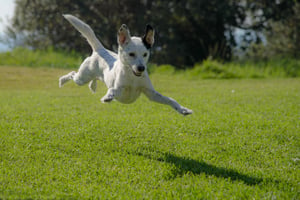Crate training a dog is an important part of dog ownership. It helps to promote good behaviour and...
Crate Training for Separation Anxiety: The Ultimate Guide
Crate training is a great way to help dogs with separation anxiety. It can help your dog feel safe and secure in their own space, while also providing them with a calm environment to settle down in. In this guide, we'll go over the basics of crate training for separation anxiety and provide tips on how to make it work. We'll also discuss how to spot the signs of separation anxiety in your dog and how to address it.
What is Crate Training?
Crate training is a method of training your dog to be comfortable in a crate or kennel. This type of training is used to provide your dog with a safe and secure environment when they are left alone. It can also help to prevent destructive behavior while you are away. The goal of crate training is to create a positive association between the crate and your dog. This means that your dog will view the crate as a safe and happy place.
It's important to note that crate training should not be used as a punishment. The crate should be viewed as a safe space for your dog. It is also important to note that crate training should be done gradually. It is not recommended to leave your dog in the crate for extended periods of time.
How to Crate Train for Separation Anxiety
The first step to crate training for separation anxiety is to make sure your dog is comfortable in their crate. This means introducing them to the crate gradually and making sure that it is a positive experience. Here are some tips for crate training for separation anxiety:
- Introduce your dog to the crate gradually. Start by putting treats and toys in the crate and letting your dog explore it. Let them enter the crate on their own and reward them with treats when they do.
- Make sure the crate is comfortable. Place a bed and blankets in the crate and make sure it is a comfortable place for your dog to relax.
- Leave the door open. This will allow your dog to come and go as they please. This will help them to become more comfortable with the crate.
- Close the door gradually. Once your dog is comfortable with the open door, start closing it for short periods of time. Reward your dog with treats when they are calm and relaxed in the crate.
- Increase the time gradually. Once your dog is comfortable with the closed door, start increasing the length of time the door is closed. Start with just a few minutes and gradually increase it over time.
By following these steps, your dog should become comfortable and secure in their crate. This will help them to feel safe and secure when they are left alone.
Signs of Separation Anxiety in Dogs
It is important to be aware of the signs of separation anxiety in your dog. This will help you to identify if your dog is suffering from separation anxiety and address it appropriately. Some of the most common signs of separation anxiety in dogs include:
- Excessive barking or whining
- Chewing on furniture or other items
- Pacing or restlessness
- Digging or scratching at doors or windows
- Excessive salivation or drooling
- Accidents in the house
If you notice any of these signs in your dog, it is important to address it as soon as possible. Separation anxiety can be a serious issue and can lead to destructive behaviors if left untreated.
How to Address Separation Anxiety
When it comes to addressing separation anxiety in your dog, there are a few steps you can take. Here are some tips for addressing separation anxiety in your dog:
- Provide plenty of exercise. Make sure your dog is getting plenty of exercise and mental stimulation. This will help to tire them out and keep them from getting bored.
- Create a safe space. Create a safe space for your dog in your home. This could be their crate or a designated area. Make sure the space is comfortable and provide them with toys and treats.
- Leave them with something familiar. Leave your dog with something familiar when you leave the house. This could be a toy or a treat. This will help to comfort them while you are away.
- Ignore your dog when you leave. When you leave the house, it is important to ignore your dog. This will help to prevent them from getting worked up and will help them to stay calm.
- Give them attention when you come home. When you come home, make sure to give your dog plenty of attention. This will help to reinforce the positive behavior and will help to reduce their anxiety.
By following these steps, you should be able to reduce your dog's separation anxiety. It is also important to remember to be patient and consistent when addressing this issue.
Conclusion
Crate training for separation anxiety can be a great way to help your dog feel safe and secure. It can also help to prevent destructive behaviors while you are away. However, it is important to remember that crate training should be done gradually and should not be used as a punishment. It is also important to be aware of the signs of separation anxiety in your dog and to address it appropriately. By following these tips, you should be able to help your dog cope with separation anxiety and create a positive association with their crate.



